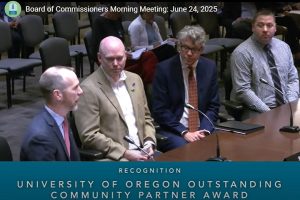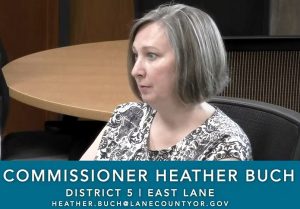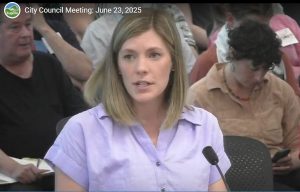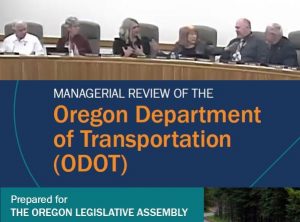Educator, parent encourage 4J to adopt new reading program
5 min read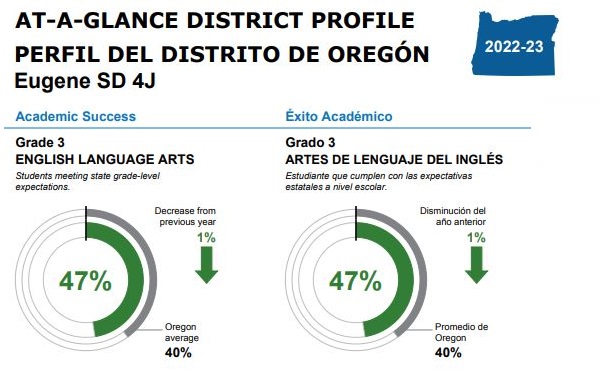
The 4J school district moves towards a new reading program. At the Dec. 6 board meeting:
Julie Jessal: My name is Julie Jessal. I am here to speak tonight on behalf of Stand for Children. I realize that you will be looking closely at the literacy program for 4J, so I’m just kind of priming the pump a little bit tonight with my comments.
[00:00:21] I’m a former educator. And I’m a grandmother of a kindergartner here at Camas Ridge. In conversations with many of you this fall, I’ve been impressed with your commitment to address reading in the 4J district in the next year.
[00:00:37] Over the past 40 years, I’ve been a teacher, a principal, district administrator, an educational expert, working in districts all across Alaska. I’ve worked with hundreds of educators, and we all have in common the desire to be consequential to our students’ academic success. The greatest disappointment is to fail at that.
[00:00:59] What an awful feeling to not be able to help a struggling reader in a classroom. I was that young teacher. How did I find myself without the knowledge to actually teach reading? My university program taught the whole language approach all those years ago. It brought great literature to kids, but it didn’t bring the discussion they needed to learn how to read.
[00:01:23] And teachers like me found that our kids were just not learning how to read. As the principal, I didn’t have the answers when a distressed parent walked into my office and said their child wasn’t learning how to read. I knew my teachers were committed. There were none more so.
[00:01:41] And they worked so hard at their balanced literacy instruction, but over half the kids in our building were not learning how to read. The teachers were working hard, but the key components of early literacy were absent. They were teaching language comprehension, but not word recognition in a systematic way.
[00:02:04] We now know that one without the other does not produce competent readers.
[00:02:09] Now one piece of the puzzle is key, I think, to changing instructional practice in the classroom. Meaningful change relies on the knowledge, leadership, and commitment of the school administrator. This person wears many hats, but instructional leadership is perhaps the most important role principals can play.
[00:02:28] All principals must understand the five essentials of reading: phonemic awareness, phonetics, fluency, comprehension, and vocabulary. They must have instructional knowledge, vision, and a commitment to elevate reading in their schools. Principals need support from the district and from the school board to set purpose and focus with their staff, set expectations for evidence-based instruction, and empower teachers through strong instructional leadership.
[00:03:00] School principals have the capacity to be our greatest change agents. But it’s not easy. I ask you to support the district in setting expectations for our school leaders and empower them to ensure all our students receive this reading instruction they need and deserve. We can’t do it without them.
[00:03:18] John Q: One parent says she asked for help, but the school district ignored her. In the first three years, her family spent $15,000 for tutoring.
[00:03:28] Anna Ingram: My name is Anna Ingram and I have two students in 4J. I appreciate 4J’s new commitment to teaching children to read with proven strategies based on the science of reading. Even though I don’t have elementary school students anymore, this shift is very important to me.
[00:03:45] My oldest son was a struggling reader in the earliest grades. But when we expressed our concerns, I was told repeatedly that his problem was speech and not reading, that he would catch up, that boys are sometimes less mature, and that eventually it would just click.
[00:04:01] They were wrong. Even though the school had data showing that my son could not read, he received no extra support. We finally got an IEP after an external evaluation diagnosis of a specific learning disability in reading, but even then, he was still not provided the kind of instruction in school that would help him learn to read.
[00:04:19] So we paid for outside tutoring. A few weeks ago, I thought I would try to figure out how much money we’ve spent on tutoring and external evaluations to help my son read. From third grade to fifth grade, just three years, the number was nearly $15,000.
[00:04:36] And I know I’m not alone. Many parents set aside other things to pay for tutors to help their children read. My son is a junior in high school now, and he’s been in tutoring consistently since the third grade. I honestly don’t want to think about how much money that is—or how families who have less privilege than ours are not able to provide that support to their children.
[00:04:57] I want to express my gratitude to the district for not only providing elementary teachers with a new ELA (English Language Arts) curriculum that aligns with reading research, but also with coaches in buildings who can continue to help teachers right with educators.
[00:05:10] I’m also grateful that so many of our elementary teachers are taking LETRS training and that the district has supported that. I cannot think of a single thing that is more important than making sure all of our students in 4J learn to read, using the methods that work best for virtually all children.
[00:05:25] With only half of our elementary students reading with proficiency, it cannot be overstated how important it is for the school board and district administration to not only put their full support behind early reading curriculum, but to put the money the district receives from the early literacy bill to good use.
[00:05:42] To put that support behind the instructional coaches to make sure that they have the training that they need to allow the coaches to make changes where it might be necessary and make sure that all teachers in our district are using the new curriculum with fidelity and with an understanding of explicit systematic instruction.
[00:06:00] Learning to read is not automatic. So thank you for stepping up to make sure our children get the explicit, systematic, cumulative reading instruction that they deserve.
[00:06:11] John Q: Parents express hope as 4J considers a new program to teach students how to read. The school board is expected to discuss the program at its Dec. 13 meeting.
